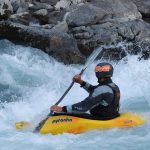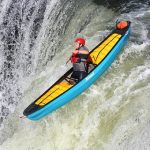Getting in and out of a kayak is usually not a breeze, but it can be particularly hard on the joints if you have weak or stiff knees.
Kayaking can be enjoyed by individuals of all skill levels and is a great recreational activity.
This guide has been created in order to demonstrate to you how to board and disembark a kayak, even if your knees don’t have the same mobility as before, so that you can still take part in kayaking activities along with everybody else.
How To Enter A Kayak With Bad Knees
Wade Out With Your Kayak
It is simpler to board a kayak when in shallow water, and it can be done by wading out with the kayak until the water comes up to about one foot in depth, or just beneath your knees.
Getting into the kayak from the water is done the same way you got out of it, only in the opposite way of what we mentioned earlier. This can be an efficient method of kayak entry.
At the launch area, firstly make sure to stand in water that comes up to your knees, and ensure that your kayak paddle is securely fastened to the kayak before sitting down. Waist deep water may be too deep for this.
Position yourself next to the kayak, facing away from it, and with your hands on the edge. Gently lower your body into a seated position in the boat. Next, move your legs so that you are completely seated in the cockpit or on the chair.
This can be among the simplest methods to board a kayak, allowing your posterior to reach the seat quickly and ensure your balance.
Slide Into The Cockpit
Getting out of and into a sit-inside can be a challenge, particularly when you have mobility issues with your knees. One method of getting into a kayak that has a seating area inside of it if you are someone with bad knees would be to position yourself over the kayak and then lower yourself in.
It is a lot simpler to accomplish this if the back portion of your kayak is on shore, with the front part submerged in the water, that way it doesn’t rock too much as you do this move. Make sure to fasten your paddle in a paddle holder or someplace secure on your vessel.
Sit in the kayak with each leg on either side of it, slowly lower yourself so that you are behind the lip of the cockpit, seated on the back deck. This enables you to get into the cockpit by bringing one leg in at a time.
Now that you have both your legs in, you can use your arms to hold you up while gradually lowering your body into the cockpit and settling yourself into the seat. Push your legs forward beneath the cockpit afterwards.
This can be a convenient way to kayak for people with bad knees or who have restricted movement.
Paddling A Kayak With Bad Knees
Navigating a kayak with weak knees can occasionally cause distress, contingent upon the type of kayak you are using, the level of comfort of your seat, and the amount of time you intend to row.
By learning the correct way to enter and exit a kayak, then utilizing both the proper techniques and gear, you can increase your comfort, diminish the intensity of pressure on your knees, and minimize the amount of knee pain that you experience.
Elevation
Raising your legs rather than letting them lie flat on the floor can be beneficial. Certain kayak chairs have the possibility of full readjustment in order to fit your frame and the way you paddle most comfortably.
Kayakers who have knee problems typically look for an upgraded seat to make paddling more agreeable, which typically adds an extra expense.
Certain kayak seating designs provide leg lifters inside the chair, making it possible to elevate the edges of the seat, thus providing extra support for the legs and preventing them from staying in the same position for too long.
The Phase 3 AirPro seat can be seen in a few Wilderness Systems kayaks, like the Tarpon 120.
An option would be to firmly place a waterproof bag under your legs to give you the necessary elevation. Using your legs while you’re out on the lake or river can help to keep them from becoming stiff. A knee brace or protective pads may be beneficial in this situation.
In some sit-on-top kayaks, especially those used for fishing, the seating area is lifted off the deck, which can make it easier to stay in one spot for extended periods of time since you can position your legs with your knees bent and feet flat on the kayak.
These types of seats can also permit you to extend and unwind your muscles every now and then by allowing you to stretch your legs, which gives you more mobility than a sit-in kayak with a closed cabin, which may be advantageous if your knees are weak.
Cockpit Padding
One way to keep your knees from coming into contact with the sides of your cockpit is to use deck or rim padding. Many kayaks come with padding for your lower body, but you might consider getting additional protection, like the NRS Padz that have self-sticking adhesive.
An additional useful suggestion: affix knee blocks to the sides of the cockpit near your thigh pads for extra stability for your knees. The knee blocks have been created to lessen the pressure put on your knees and offer further backing for better general ease.
How To Get Out Of A Kayak With Bad Knees
The Shallow Water Exit
We are going to go over a technique that we refer to as the shallow water exit. Once you are certain of the depth of the water, swing both of your legs to one side of the Kayak.
Position yourself at a right angle with the Kayak and lower yourself until your feet touch the ground. This technique will help you to get out of a seated position rather than going into a full squat.
If you have to enter a body of water with lily pads, which are not sitting atop a firm surface, this would be a great solution. If it is not possible to get out of shallow water and you must stay sitting in the water (or you cannot lie down in the seat), try to keep your feet as close together as you can.
Bend your knees slightly so that they align with your hips.
Check The Depth Of The Water.
Use your paddle to measure the depth of the water before getting in. If you’re out on the water in a Kayak, examine the area around you to see if there are any large stones or tree logs laying close to your boat.
Go a small way out to sea, in roughly water that is level with your waist, to get ready for this selection. The following step is to invert your boat and take a dip.
It will be easier for you to stand up in a kayak if your feet can reach the bottom of it. The most effective way to navigate while afloat is to use your hands to direct the boat as your arms will not be required. There are a considerable number of individuals who are unaware of this fundamental truth;
it is underlined by those who partake in seafaring kayak trips as one of the blunders made consistently by those who are unfamiliar with kayaking.
Give Your Kayaks A Couple Of Extra-Strong Paddle Strokes
Power your Kayak with a few more vigorous paddle strokes in order to glide closer to the shore when you make it to the beach. You’ll now position your body on one side at a 90-degree angle to the ground, just like you did when starting in shallow water.
It makes no difference which side you pick, however, if one of your legs is more robust than the other, you might opt for that side. It is nice to be able to disembark from a kayak when using it specifically for fishing, getting onto the opposite side from where you started.
You can locate a gap between your boat and the ocean conveniently close to the hull, and then commence to paddle toward the coast.
Make sure you keep your distance from any rocks as they may cause serious damage to your kayak. Be prepared to cope with the most unfavorable outcome when disembarking on a boat.
If you’re floating in shallow depths or the water has receded, and there are chunks of rocks present, entering into a kayak under these circumstances might be seriously hazardous.
Make Sure to get Your Kayak As Far Up Onto The Shore As Possible
You will need to create force similar to the way you did previously, so that the bow of your Kayak travels as far onto the beach as possible when you arrive. If all other strategies are not successful, it is acceptable to try the climb-away approach.
This tactic might appear comical to onlookers, but it is functional, and who really cares what other people think? Maybe a couple of folks are due to the fact that we are cruising in the absolute middle of nowhere.
There is no way to instantly transport you to the beach whenever you want. You’ll need to decide on a velocity and count on your paddling technique and timing abilities. But what happens if you don’t have anywhere to land? Embrace the coastline and keep rowing to the following location.
This may appear to be obvious, but it’s worth considering. If you’re in kayaks, you will have to row against the waves (and breeze) when disembarking.
Make Sure The Water Is Deep Enough
If you have weak joints, the simplest way to exit your Kayak is to make sure the water is deep enough so as to not hurt yourself on the ground. Sit-inside kayaks are likely easier to control than sit-on-top kayaks.
Make sure to attach your paddle to the boat to stop it from leaving, and secure your life jacket properly.
Once you’ve identified a safe site that is close to the ocean, horizontally incline your body, making your Kayak topple over, letting the weight of your body draw the Kayak away from the shoreline. If your knees are weak, the safest approach for exiting your
kayak is by ensuring the water is sufficiently deep to avoid any potential harm from the seabed. Sit-inside kayaks may be more easily directed than sit-on-top kayaks.
Try To Get As Near To The Coast As Possible
Attempt to come as close to the shoreline as feasible, if possible in two feet deep of liquid and on a sandy shoreline. Paddle until the front of your Kayak is securely settled on the shore – this could assist in steadying your body and kayak.
You now have the ability to place both of your feet in the water, use the cockpit as leverage, and get up on your feet. In a confined cockpit, you need more legroom to balance yourself while making the switch.
Approach the shore with your Kayak, keeping the front end pointed directly at the land and positioning yourself to be facing the land. It is advisable to enroll in a refresher class and put in some effort to develop your paddling skills since the activity is so different.
Call For Help
If you’re by yourself with other people present, you may want to ask for help. Recruiting the aid of others can be more straightforward than attempting to take on the task yourself.
Fortunately, the majority of people are knowledgeable and are aware of how to act. If the circumstances are dire, it is advisable to contact someone you have faith in.
Have no fear in seeking assistance if you’re trying to determine what actions to take next. Cooperation amongst members of a group can make it simpler to make sure everybody is on the same page. I have encountered several individuals who feel like a defeat for them if an answer isn’t determined by them independently, regardless of what the universe has to offer.
Is It Difficult To Enter And Exit A Kayak?
It may not be easy at first, but with some practice you will become proficient at entering and exiting a kayak. With patience and repetition, you will master the technique. If you are nearby the beach, overturning your Kayak is not a huge issue, yet there are other elements to take into account, for instance slipping off a pier or colliding with an old fishing net from the previous year.
If you don’t feel like mastering the process of going in and out of a kayak, other people are sure to be able to provide some guidance. It’s pretty straightforward.




